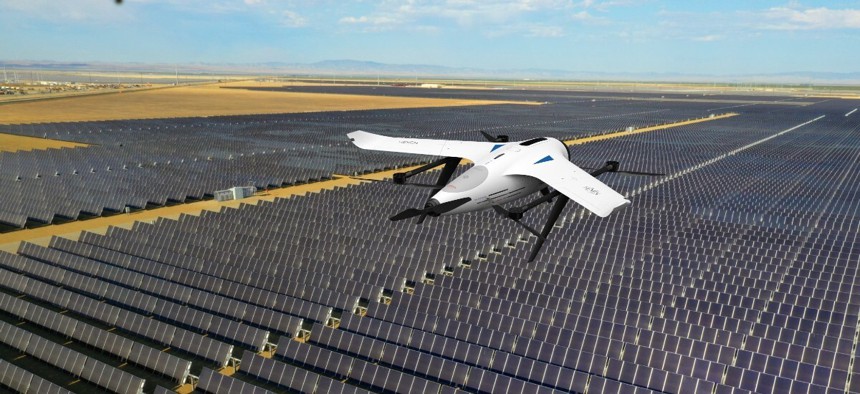Could hydrogen help overcome today's battery limitations?

A Hevendrones H2D200 flying over a solar panel farm. Courtesy of Hevendrones
The four-year-old startup HevenDrones sees hydrogen as what will power the vehicles for longer durations, helping them enter new mission fields, such as contested logistics.
A vast majority of today's use cases for unmanned aerial vehicles involve putting cameras or sensors, or both, onto the system that goes out to collect information and send it back down to the ground.
Substantially all of today's use cases for drones have one problem in common that extends to just about every kind of portable technology: typical battery lives are not where anyone wants it to be.
China's dominance of supply chains for batteries and the critical raw materials that go into them is not helping matters either.
"The promise of electric and batteries really is hitting a wall," said Bentzion Levinson, co-founder and chief executive of UAV startup HevenDrones. "If you look at the energy density needed for a drone, battery technology just doesn't have it: we're talking about 30, 40, maybe close to an hour of flight with batteries."
HevenDrones opened for business in 2019 in Israel and has evolved into a specialist in making drones powered by hydrogen. The company's thinking behind that is the vehicles can fly for longer periods and carry more payloads than those relying on batteries.
Levinson told me the company currently has dual headquarters there and in Miami. HevenDrones started out in Israel to gain traction in early adoption among that customer set, but is increasingly looking at the U.S. military as another main market.
At the Monaco Hydrogen Forum on Monday, HevenDrones unveiled its H2D200 drone that is designed to carry up to 10 pounds at a time and fly at ranges of up to 317 miles. That translates to up to 4 hours of flight time.
The sibling platform H2D250 is built to carry between 14 and 22 pounds at a time and fly for up to 8 hours or around 466 miles.
Levinson cited congested logistics as one of the use cases HevenDrones is eyeing for its vehicles. He sees having fleets of 30 drones to resupply soldiers in the field with food or ammunition is one possibility.
"We believe very strongly that hydrogen is what will allow drones to scale from an operational perspective," Levinson said. "If drones can now go out for a few hundred miles, the new drones can go beyond 400 miles, then all of a sudden you're replacing helicopters and that economic aspect makes a lot more sense."
HevenDrones is taking its new vehicle offerings to market with a belief that the economics of hydrogen production are about to change more quickly. Hydrogen is a key component of the Defense Department's Operational Energy Capability Improvement Fund aimed at guiding innovation via targeted science and technology investments.
The fund has invested $250 million into 60 projects that involve partnerships with industry, academia and research laboratories. DOD also requested $112.2 million in its fiscal year 2024 budget proposal for the development of low carbon fuels such as hydrogen.
As Levinson pointed out, an early adopter of technology such as HevenDrones means it has to take some risk. Which means that a slower adoption on the customer's part can present problems for the company's outlook.
"If it takes five more years to adopt hydrogen, this could be a very, very hard hit for a company like ourselves," Levinson said. "So I think that jump in confidence is very important. Both from the DOD and DOE, there are very specific discussions that aren't just feel good statements, there are specific needs that we are engaging in and working on solving that we can answer."


